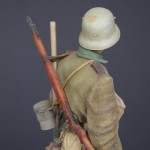
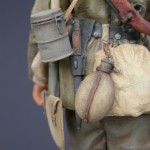
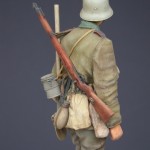
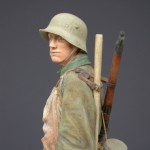
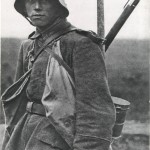
Stormtrooper Infantryman, Assault Battalion, Western Front 1918
- Scale / Maßstab: 1:16
- Approx. height of figure: 112 mm
- Material: Resin (figure), Model Plaster (base) / Modell-Gips Sockel (synethetische, kunststoffveredelte Gießmasse)
- Parts / Teile: 23
- Infosheet / Infoblatt: English
- Code: 08ST
Contents / Inhalt:
- Figure (8 parts) / Figur (8 Teile)
- 2nd Alternative Head / 2. Kopf
- 2 x Grenade Bags / Tragebeutel für Handgranaten
- Water Bottle M1997 / Feldflasche M1907
- Haversack M1887 / Brotbeutel M1887
- Gas Mask Tin M1917 / Gasmaske M1917 Metallbehälter (Bereitschaftsbüchse 17)
- Army Spade M1822 / Heeresspaten M1822
- Pickaxe / Spitzhacke
- Bayonet 84/98 / Seitengewehr 84/98
- Mauser Carbine 98 AZ / Mauserkarabiner 98 AZ
- 2 x Straps / 2 Stck. Riemen
- Stick Grenade M.15 / Stielhandgranate M.15
- Steel Helmet M1916 / Stahlhelm M1916
- Figure Base / Figur-Sockel
- Empty Ammunition Cases / Leere Patronenhülsen
Extracts from the Infosheet with this figure:
Steel Helmet M16 / Stahlhelm M.16: This helmet, which first entered service in 1916 during the initial stages of the battle of Verdun was designed by Professor Friedrich Schwerd and made from high quality chrome-nickel steel. Weighing between 950 and 1200g, depending on size – more heavier than the Allied helmets, but giving a better protection to the face, ears and neck. The horn venting bolts on each side enabled the fitting of an extra armoured shield over the helmet (also available in 1:16th scale from Jon Smith Modellbau) for sentries, MG troops, snipers or other particularly exposed / dangerous employment. This weighing around 2000g was seldom used; although a total of 50000 were supposedly produced.
Colour: first issued in field- grey, which would reflect in sun light and proved unsatisfactory. Various trials were carried out, but it was not until July 1918 that an official camouflage scheme in brown and green sharp-edged irregular patens, all outlined in black was introduced. These were carried out by unit maintenance workshops (other weapons and equipment, particularly artillery pieces and MGs were also rendered in the same way). It seems that helmets were re-painted by individuals or units in a variety of colour schemes before the official order and items with red- brown, ochre (brownish- yellow), green and blue- grey, all outlined in black were common. Helmets were also covered using the light brown sandbag material, or the issued helmet-covers, seen particularly in the later war period.
The M.17 & 18 helmets followed with only slight differences to the inside padding and chin strap fasteners. The last model to see service during the war, if only in small numbers was the M.18 Ohrenausschnitt, or Helmet M.18 with ear cut-outs (also available in 1:16th scale from JSM), more commonly (and stubbornly) known as the Cavalry or Telegraph Helmet. The cut-outs were in fact a further design feature of the M.18 to improve the hearing ability of the wearer and avoid the hissing noise experienced by troops.
The resin chin strap supplied (a 2nd reserve strap is also supplied) can be formed around the figure’s head using the application of heat (either hot water or hairdryer, holding of cause with tweezers etc.). One may want to thin out the strap before application. The length of strap will need shortening, using the finished head / helmet already completed. Alternately, one can use the brown card supplied, which can represent leather or material chin straps etc. Cut the card approx. 1.1 mm wide and 25 mm long and flatten or rub down on a hard surface with a blunt tool (handle of a modelling knife is ideal). Bend the strip around a pencil to give a natural curve, cut ends to match length and glue into position on the figure. The colour, thickness and texture achieved from rubbing down the card gives a good reproduction of leather in this scale.
Field Service Dress / Feldbluse M1915: This was to replace the early M1907/10 and the simplified M1914 service dress tunics. All three were in fact worn alongside each other throughout the war. The Bluse was a radical change in the design of combat clothing, with trials before the war and the new experience gained at the Front producing a garment without the unnecessary elements of the earlier tunics, giving the German soldier a completely different, in some cases baggy appearance. Designed for all arms of the service and for all ranks (Officers were allowed to acquire the Bluse in a better quality of material, but were not permitted to show difference in colour from the other ranks). The six buttons were hidden behind a flap and quite often stormtroopers had leather patches on the elbows.
Colour: made out of a field grey material (the Light Infantry units, or Jäger and Schützen wore a green-grey version). All units had the turn down collar in resedagrün reed-green, exception being the Bavarians, who retained the field-grey material, piped on the outer edge (later only the front, vertical edges) in the State colours white / blue Rautenborte, a particular feature of Bavarian troops. The six front horn buttons to the Feldbluse were hidden behind a flap. The pocket and large rear buttons were cast in zinc and coated in nickel or Tombak (an alloy of copper and zinc, which had a matt bronze/yellow colour).
Note: with a bit of care and a thin, sharp blade it is possible to hollow out the gap between the right shoulder strap and tunic. There are also casting webs underneath the collar and pocket to be removed.
Mauser Carbine 98 AZ / Mauserkarabiner 98 AZ: (more commonly known as the K98, this being a post war designation – AZ stands for Aufplanz- und Zusammensetzvorrichtung – one could stand the carbines up in 3s linked to each other by means of the metal hook, at the end of the barrel). Many of the stormtrooper units were equipped with this Carbine 98 AZ, which was shorter and therefore easier to handle than the standard issued Gewehr 98 rifle used by the infantry. They both had about the same performance within the reduced ranges of trench warfare. A further advantage over the Gewher 98 was that the bolt folded down against the stock of the carbine, therefore reducing the danger of being snagged on uniforms and equipment etc.
Grenade Bags / Tragebeutel für Handgranaten: Made out of sandbag or other material and tied together with a cord over the shoulders, behind the neck and waist. It was a common practice and ideal for carrying grenades of all kinds, incl. spare ammunition. Colour: brown to light- brown.
Army Spade M1822 / Heeresspaten M1822: Carried in a canvas holder attached to the belt and shoulder strap (they used, amongst other things the leather coat fastening straps from the Tornister – rucksack). Assault troops had to at times quickly dig-in, or repair or reverse newly taken positions. A pickaxe is supplied with the figure as an alternative. Colour: shaft – natural wood. Canvas holder – brownish-yellow, reinforced leather edges to holder.
Note: although some illustrations show this soldier supplied with the army spade, it is clearly visible on the original photograph that he is carrying a pickaxe. I have supplied both items with this figure.
Metal Cup M1916 / Tasse M1916: The enamelled steel cup replaced the earlier aluminium version (production was discontinued in October 1914 due to lack of aluminium) and can be fixed to one of the bread bag fastening straps. The opposite end to the handle is a small indent in the rim to allow the cup to be used as a small jug. The official place for this cup was inside the bread bag. Colour: light olive green / field-grey.
Note: I have seen various photos of this item being fixed to the bread bag fastening strap above the water bottle – the handle may need to be cut open, depending on where it is fixed.
Gas Mask M17 Tin / Bereitschaftsbüchse 17 für Gasmaske M1917: The gas mask was kept in a metal container, which had a brown cloth / canvas strap. Troops serving in the front area often wore it in the alert position at the front of the chest. There was no room for the reserve filter in the container; this was normally kept in the bread bag. Through constant use the containers became easily dented. The seam on the side of tin is where the metal is joined together (not a cast line). Colour: grey or green-grey.
 An deutschsprachige Interessenten:
Sie können mich per eMail oder Telefon auch gerne auf deutsch kontaktieren. Ortsbesuch ist nach Absprache möglich.
An deutschsprachige Interessenten:
Sie können mich per eMail oder Telefon auch gerne auf deutsch kontaktieren. Ortsbesuch ist nach Absprache möglich.
